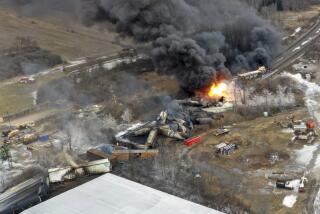‘SDI Is Not for Don Quixote’
- Share via
A thoughtful reading of Colin S. Gray’s article (Editorial Pages, Sept. 15), “SDI Is Not for Don Quixote,” exposes the shakiness of the ground that “Star Wars” proponents are now standing on.
If one deletes the vague promises, hand-waving, unfounded assertions, faulty analogies, and outright inaccuracies, there is nothing left of Gray’s article.
Yes, there is something “inherently fanciful” about the idea of strategic defense in the Nuclear Age. In an earlier, conventional war, a 10%-20% effective defense against aerial attack was a good one: the enemy could not long sustain such high attrition. Even Strategic Defense Initiative zealots no longer claim that we will ever have better than a 70%-90% effective defense against the present arsenal of Soviet ICBMs.
Sounds good enough? First consider what a 99% effective defense could do for us. In that case, approximately 100 large hydrogen bombs would penetrate the shield. Even if these bombs did not explode near our largest cities, it would be a catastrophe far beyond any other in history. And the Soviets would still have their “huge arsenal” of bombers and submarines--untouched by a space defense.
A defense worthy of the name must be extremely intricate, flexible, quick, and must work correctly the first time in action. Nuclear bombs, on the other hand, can do their horrible work even if they miss their targets by miles--the advantage is with the offense. Arms experts understood this several decades ago and it is even more true today.
Colin Gray claims that President Reagan’s original vision does not imply that we must intercept every Soviet nuclear warhead. But if significant numbers of bombs are able to get through to blast us back to the Stone Age (or farther), then in what sense are they “impotent and obsolete?”
SDI is claimed to promote Soviet disarmament by making Russian leaders uncertain of the effectiveness of their first strike. He ignores the fact that there are already several good reasons for them not to launch an attack: (1) There is low probability that Soviet ICBMs would function as planned and would destroy all their targets; (2) our ICBMs are solid-fueled and could be launched before Russian missiles arrive; (3) we have a formidable bomber and submarine retaliatory force that would not be eliminated by an attack; and (4) global environmental effects could destroy the U.S.S.R. even if we did absolutely nothing in response. By Gray’s standards, Soviet missiles have already lost their “military and political value.” So why aren’t they being disassembled now?
SDI critics are not running out of arguments. They are running out of Star Wars proposals that haven’t yet been laughed out of town. Neither have opponents dropped charges that SDI will be highly destabilizing. Gray acknowledges that Soviet leaders “may anticipate doing better by going first than by going second” (under SDI), but he wonders why “such an attack (would) be the preferred policy choice.” The answer is that, preferred policy or not, in a time of tension, crisis, or accident, if the Soviets think they will be better off by striking first, we can expect them to strike first. If that’s not destabilizing, what is it?
An additional peril of Star Wars is that it will require continuous high-speed processing and interpretation of vast amounts of data and that decisions will be made within seconds. We will move into a computer-controlled, hair-trigger world, where a minor error or malfunction could immediately escalate to a full-scale war without human participation. We can count ourselves extremely lucky to have survived the hundreds of minor and not-so-minor false alarms during the past 25 years. Under SDI, only a sustained series of miracles will save us.
PETER F. GRAY
San Marino
Gray is a member of the Space Weapons Study Group at Caltech.
More to Read
Sign up for Essential California
The most important California stories and recommendations in your inbox every morning.
You may occasionally receive promotional content from the Los Angeles Times.










